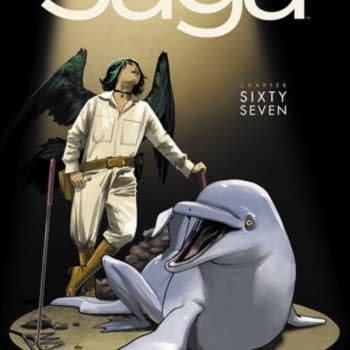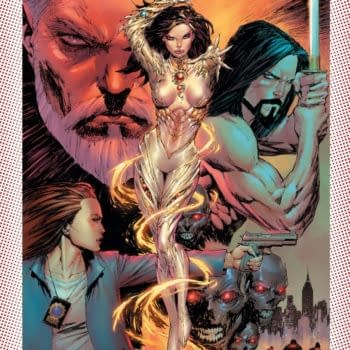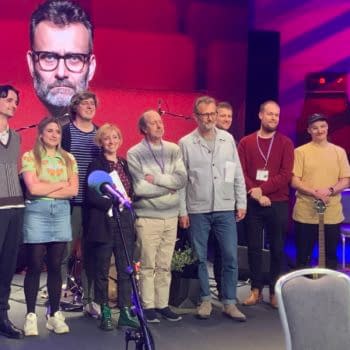Posted in: Recent Updates | Tagged:
Twenty-First Century Stories And Art #1 by Kimberly Cox

She's also a little bit right-wing. Imagine Anne Coulter, just without the desire to baptise Iraq.
So I'm fascinated with all this new technology. We all wonder how it's changing our society. I'm here to talk about how it's not, as opposed to talking about how it does. It's too soon for us to know. And in the meantime, it's important to not forget about what has kept us, US, for hundreds of years.
I'm talking about art and story telling: theatre, comics, music, pictures, design. While society changes, these things change in tandem. We learn from history that each of these artistic practices reflect the time in which they are created and the zeitgeist of an era.
Let's not walk in circles. Today, we have comic books, theatrical productions, movies, books, the internet, radio (an ever changing medium and solid despite what some may think.)
But do they reflect who we are as a society? This is the question I want to get you thinking about and talking about. In many ways, the art that I see being created does, but a lot of the Mass Media or Mainstream Media (MSM) doesn't resemble the art I am talking about. I'm talking about the difference between Ashton Kutcher and Paul Pope. The difference between Chris Nolan and Frank Miller. The difference between American Idol and 24 or Fringe. Dan Brown or Victor Davis Hanson?
I'm not good when it comes to analyzing visual art so I will leave that to someone who is more of an expert than I, BUT I do have a solid sense of theatrical theory and practice. What does that mean? I've studied the history of performing arts. Of storytelling. So it gives me a solid standing in that arena.
We don't seem to be thinking about history in the MSM. That does not mean that we have forgotten about it. I think the MSM just thinks they don't owe history anything. Like Zeus when he first became a god, the MSM is boistrously arrogant and enjoying it's current reign over the older gods of theatre and pictures. Here I am, playing Aeschylus's Prometheus when he tells the Ocean that Zeus would one day be sorry for it.
The art I see be created and the storytelling I see happening again, is very different from what I see in the MSM. So I ask you to think about history. In the theatre, the 20th century saw innovation beyond Aristotle's wildest dreams. We also saw this happen in radio and cinema. Is the quality today better than it was then? In the MSM, it is not, but if you know where to look, you see that respect for history in places from time to time.
In the early twentieth century, theatre began to break from the traditional Aristotelean approach to story telling. You had the Da-Da movement in the 1920s that pushed the Theater of the Absurd into being. Then you had Bertholt Brecht in the 1940s and 1950s breaking the fourth wall and pushing for a narrative being told differently to an audience. This does not mean that the Aristotelean Tradition was forgotten in any way. The schism in approach reflects the period of history and social change we were going through.
What about comic books? Are comic books today, better or worse? My cousin, Travis, told me recently that he was starting to view modern day comic books as soap operas. There are still some he likes but mostly, the big publishing houses release the same story, with the same characters in the same predictable plot.
Frank Miller answered this when I posed the thought to him, "I remember working with David Mazzuchelli on BATMAN YEAR ONE. I picked up some EC Comics done by Johnny Craig, thinking that was where he was going and would help this talent flourish further. But David hearkened back more to Chester Gould and DICK TRACY in the 1940s. The starker bolder style. David went on to do things like RUBBER BLANKET, a cruder more direct way of using comics as pure visceral story-telling.
I also have to mention Neal Adams here. He brought a more illustrative, draftsmen oriented approach which goes back to Mac Raboy and Alex Raymond of FLASH GORDON fame in the 1940s. This tradition was also carried along work done by Robert Crumb and Richard Corbin in the 1960s. KRAZY KAT, by E.C. Segar, as early as the 1920s, began an approach to comics that has been invigorating. There is a new generation carrying it on.
There is a schism between this and the more traditional Neal Adams approach. You have Jim Lee and James Kolchalka. Kolchalka's work is defiantly anti-draftsmenship while Jim Lee creates a visual tapestry for the eye. I see these as two approaches and they are getting further apart."
I think we are entering a period similar to that of the 1920s and are seeing a new break in the schism. People have the ability to use the internet now and to say that has not affected what we are seeing being produced? Yes, it has and the question I am asking myself now is, HOW is that affecting us?
Josh Adams had this to say, "From my point of view things like storytelling fundamentally are a constant. We will always have rules to either be followed, broken or bent, but they will still be there. I think the real key is influence vs insight. When we are young we are exposed to film, television, comics and theatre etc and we enjoy them for what they are but as we grow to adolescence we start to form our own opinions and our own wants for these art forms but of course we can't affect that change till we are of an age to make that happen. Influence begat insight begat evolution. We don't really think about it but from a creative point of view we always are asked the question "who influenced you?" and from there we take that and create our own image. My father always notes my affinity for Metallica and how they sound like they are heavily influenced by blues and classic literature."
Design and the application of design platforms are being innovated. Recently, AVATAR made a big splash in cinema for this very reason. However, remembering not to forget the story and the truth of the story can be overwhelmed by the new technology. Forcing the technology forward into 3D, AVATAR's a visual spectacle. However, the story travels in the direct opposite of where I want to see a story go. That's not a criticism. The story fit the platform it was designed for and indicated we are taking steps the way Adolph Appia took steps in his set designs in the later 1800s and early 1900s. But I am talking about James Cameron's AVATAR, and he is not Anton Chekhov, nor is he Wagner.
As Da-Daism went to the extreme of the absurd, by scripting their productions from words drawn out of a hat, what inspired its founder, Tristan Tzara, was the losses suffered during World War I. That is to say, for him, looking at an entire generation devastated by the global war, he rejected the value of looking at the world as being an orderly place. He saw such a loss as reflecting a loss for meaning. And so he scripted his plays with words drawn from a hat.
Getting back to design platforms at the turn of the 21st century, we see people innovating our approach to how we tell a story. You have a good sense now that what I am asking you to remember, as an audience, and to seek out, as an audience, is not necessarily what the MSM may be telling you. While papers my rave about the new broadway production of this or that, a small production on a Monday night in downtown Manhattan may be more of what you, as an audience, seeks out. Just as in the theatre, this is true of everything from comic books to movies to art and forums on the internet. The question is can you find it before it goes away?
It's difficult in this day and age to nail down to good ones but we can still do it. Remember that tradition only informs the modern day practice of story telling and art. And as an audience, we do have a respect for history. Despite what some may think, the audience today is smarter than given credit. The MSM does not cater to an intelligent audience and nor do we, as an audience, care much to cater to it. Sure it's hot right now to watch CNN or FOX NEWS but there are now online venues, like Andrew Breitbart's Big Hollywood and Arianna Huffington's Huffington Post. These are both offered on a new media platform and offer a new media approach to the news.
So I decided to ruminate on this using my favorite new media platform, TWITTER. I asked some people I follow to share their thoughts. Someone really hit on it, when speaking in reference to comic books and whether the 21st century is seeing better ones than in the 20th century: It's hard to say – they go through cycles where the stories and art are excellent and then it all goes wrong and then right. A different user contributed this thought: there was more experimentation at the onset of the medium shaping itself in the early part of the twentieth century. "It takes a freight train to get the comic book industry to adapt now a days. I think the time for experimentation is back though," this user went on to say, "with the way the internet and the publishing medium are finally catching up to one another."
Another person nailed it when questioning the whole topic in and of itself as being too broad. It is broad, but I want to get you, the reader, to start thinking about what has inspired you and why.
When we return to the works of the past, it is not the past that awakens, but we ourselves who cast our shadows into the past….
To move the medium forward you have to look back, but carbon copies of carbon copies just make for forgotten works…
In conclusion, the essence of what makes art and storytelling worthwhile, is seeing a story told in an innovative way. No matter what era of history you pick however, there is a considerable amount of good works from each period and also, a plethora of crap to have to filter out. Today, the MSM is producing the majority of this crap. Or at least, I hope so. Hopefully, the gems that will survive will prove what I, as the audience, see NOT reflected in the MSM.
Just like the 1920s could not have predicted where the advances in practice and theory would lead in the 1940s and 1950s, we cannot predict what we will be seeing in 2040 or 2050. What we will see is how the parallel continues between the history of culture and the art a culture produces.
TO BE CONTINUED….











